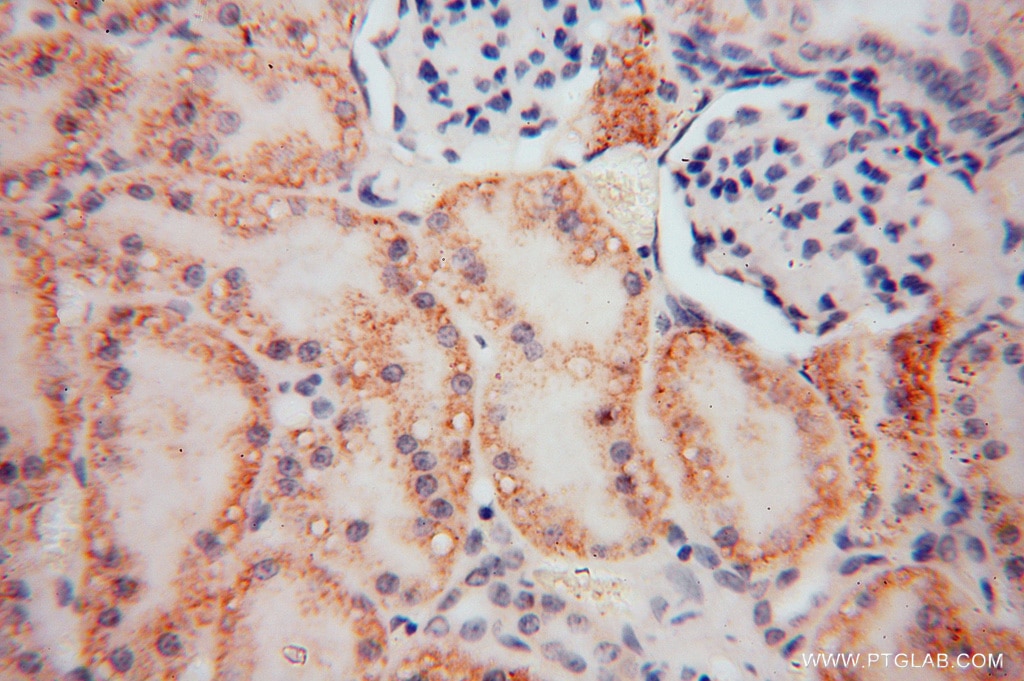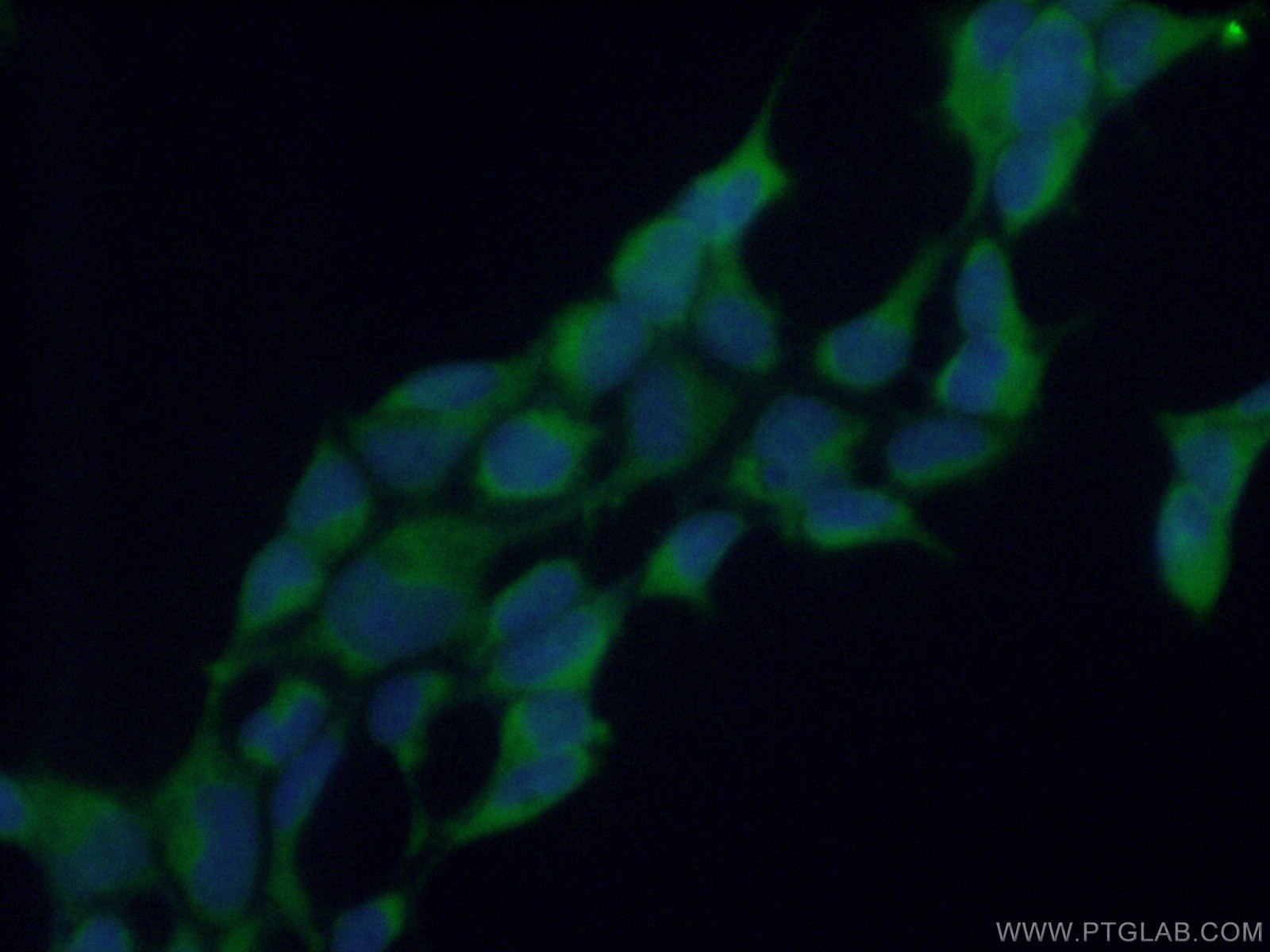Tested Applications
| Positive WB detected in | Caco-2 cells |
| Positive IP detected in | HEK-293 cells |
| Positive IHC detected in | human kidney tissue Note: suggested antigen retrieval with TE buffer pH 9.0; (*) Alternatively, antigen retrieval may be performed with citrate buffer pH 6.0 |
| Positive IF-P detected in | mouse kidney tissue |
| Positive IF/ICC detected in | HEK-293 cells |
Recommended dilution
| Application | Dilution |
|---|---|
| Western Blot (WB) | WB : 1:500-1:1000 |
| Immunoprecipitation (IP) | IP : 0.5-4.0 ug for 1.0-3.0 mg of total protein lysate |
| Immunohistochemistry (IHC) | IHC : 1:20-1:200 |
| Immunofluorescence (IF)-P | IF-P : 1:50-1:500 |
| Immunofluorescence (IF)/ICC | IF/ICC : 1:50-1:500 |
| It is recommended that this reagent should be titrated in each testing system to obtain optimal results. | |
| Sample-dependent, Check data in validation data gallery. | |
Published Applications
| KD/KO | See 1 publications below |
| WB | See 7 publications below |
| IHC | See 2 publications below |
| IF | See 3 publications below |
Product Information
15003-1-AP targets RENALASE in WB, IHC, IF/ICC, IF-P, IP, ELISA applications and shows reactivity with human, mouse, rat samples.
| Tested Reactivity | human, mouse, rat |
| Cited Reactivity | human, mouse, rat |
| Host / Isotype | Rabbit / IgG |
| Class | Polyclonal |
| Type | Antibody |
| Immunogen |
CatNo: Ag13061 Product name: Recombinant human RENALASE protein Source: e coli.-derived, PET28a Tag: 6*His Domain: 1-342 aa of BC005364 Sequence: MAQVLIVGAGMTGSLCAALLRRQTSGPLYLAVWDKADDSGGRMTTACSPHNPQCTADLGAQYITCTPHYAKKHQRFYDELLAYGVLRPLSSPIEGMVMKEGDCNFVAPQGISSIIKHYLKESGAEVYFRHRVTQINLRDDKWEVSKQTGSPEQFDLIVLTMPVPEILQLQGDITTLISECQRQQLEAVSYSSRYALGLFYEAGTKIDVPWAGQYITSNPCIRFVSIDNKKRNIESSEIGPSLVIHTTVPFGVTYLEHSIEDVQELVFQQLENILPGLPQPIATKCQKWRHSQVTNAAANCPGQMTLHHKPFLACGGDGFTQSNFDGCITSALCVLEALKNYI Predict reactive species |
| Full Name | chromosome 10 open reading frame 59 |
| Calculated Molecular Weight | 38 kDa |
| Observed Molecular Weight | 35 kDa |
| GenBank Accession Number | BC005364 |
| Gene Symbol | RENALASE |
| Gene ID (NCBI) | 55328 |
| RRID | AB_1557298 |
| Conjugate | Unconjugated |
| Form | Liquid |
| Purification Method | Antigen affinity purification |
| UNIPROT ID | Q5VYX0 |
| Storage Buffer | PBS with 0.02% sodium azide and 50% glycerol, pH 7.3. |
| Storage Conditions | Store at -20°C. Stable for one year after shipment. Aliquoting is unnecessary for -20oC storage. 20ul sizes contain 0.1% BSA. |
Background Information
RNLS, also named as Renalase, C10orf59 and MAO-C, belongs to the renalase family. It is probable FAD-dependent amine oxidase secreted by the kidney, which circulates in blood and modulates cardiac function and systemic blood pressure. RNLS degrades catecholamines such as dopamine, norepinephrine and epinephrine in vitro. It lowers blood pressure in vivo by decreasing cardiac contractility and heart rate and preventing a compensatory increase in peripheral vascular tone, suggesting a causal link to the increased plasma catecholamine and heightened cardiovascular risk. High concentrations of catecholamines activate plasma renalase and promotes its secretion and synthesis. RNLS has physiologically relevant catecholamine-oxidizing activity. (PMID:15841207 ) This antibody is specific to RNLS.
Protocols
| Product Specific Protocols | |
|---|---|
| IF protocol for RENALASE antibody 15003-1-AP | Download protocol |
| IHC protocol for RENALASE antibody 15003-1-AP | Download protocol |
| IP protocol for RENALASE antibody 15003-1-AP | Download protocol |
| WB protocol for RENALASE antibody 15003-1-AP | Download protocol |
| Standard Protocols | |
|---|---|
| Click here to view our Standard Protocols |
Publications
| Species | Application | Title |
|---|---|---|
J Clin Invest Renalase is a novel, soluble monoamine oxidase that regulates cardiac function and blood pressure. | ||
Front Cardiovasc Med Aerobic Exercise Training Improves Renal Injury in Spontaneously Hypertensive Rats by Increasing Renalase Expression in Medulla. | ||
Life Sci Renalase is localized to the small intestine crypt and expressed upon the activation of NF-κB p65 in mice model of fasting-induced oxidative stress. | ||
Exp Biol Med (Maywood) Plasma and urine renalase levels and activity during the recovery of renal function in kidney transplant recipients. |














